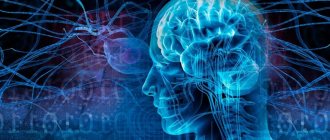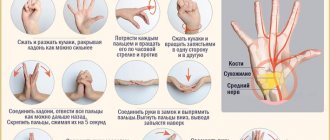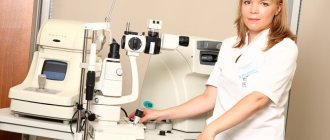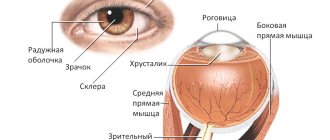Numbness in the hands is the first signal to make an appointment with a neurologist. Numbness often indicates inflammation, damage, or compression of sensory nerves. With numbness of the limbs, pain and tingling may occur, muscle tone may decrease and movement of the limbs may be impaired - this is the result of damage to mixed nerves, which include both motor and sensory fibers.
People of certain professions should pay more attention to the numbness that occurs. There is a group of professions that are more likely to be susceptible to carpal tunnel syndrome, which causes frequent pain, numbness and tingling that affects the entire hand. If you are: a driver, a cashier, involved in jewelry making, programming or music, then you are more at risk than others of getting an occupational disease, you should monitor your health more carefully.
If you have direct or indirect symptoms, you should be examined by a neurologist; these symptoms may include:
- Sudden numbness, localized or spreading throughout the body.
- Prolonged feeling of weakness.
- Difficulty breathing.
- Numbness in the arms or legs.
- Loss of sensation in the face and torso.
Causes of numbness
Both physiological and pathological factors can provoke hand numbness.
Temporal or physiological factors
Physiological (temporary) causes of numbness include:
- Spending a long time in a position where one arm is thrown over the armrest. This leads to pressure on the nerve endings, which causes some discomfort.
- Carrying a heavy bag or backpack. In this case, the pressure will be exerted by its straps. Numbness occurs due to impaired blood supply to the limb.
- Wearing clothes that are too tight.
- Frequently raising your arms above your shoulders.
- Spending a long time in the cold. Numbness occurs due to vascular spasm.
All of these factors do not pose any threat to health. To prevent numbness, you need to change your position more often, massage the limb, do light exercises, and change the position of your backpack or bag. The danger comes from pathological causes that lead to numbness in the hands.
Pathological factors
Fingers may become numb due to pinching of nerve endings and blood vessels in the wrist area. Connective tissue can put pressure on them. If the numbness goes away quickly after a change in position, or after rubbing the tissues, then this symptom can be ignored. If numbness occurs frequently, persists for a long time, and it is not possible to cope with it with massage and changing posture, you need to consult a doctor. Such a symptom may indicate pinched nerve fibers or a disruption in the blood supply to tissues.
The reasons can be very serious. Among them:
- Polyneuropathy. This pathology is accompanied by damage to the nerve trunks of the peripheral nervous system. In addition to numbness, the patient will develop weakness in the hands, and their tissues will begin to atrophy, that is, dry out. The patient suffers from cuts (partial impairment of movement). Sometimes paralysis is observed, that is, the functions of the limb will be completely lost. The cause of polyneuropathy may be diabetes mellitus, alcoholism, diphtheria, hemoblastosis, porphyria, periarteritis nodosa, systemic lupus erythematosus.
- Stroke. With this pathology, there is a disruption in the nutrition of the brain. Ischemic stroke most often leads to numbness of the extremities. People's hands go numb at rest, and tingling occurs in them.
- Neuroses.
- Shingles.
- Damage to the nerve nodes of various parts of the spine. The cervical, shoulder, and lumbosacral regions may be affected. With such pathologies, in addition to numbness, a person will suffer from pain. It will be localized in those places for the innervation of which the affected nerve plexuses are responsible. The most common pathology is osteochondrosis.
- Median nerve lesion syndrome. This pathology is called pronator syndrome, carpal tunnel syndrome, etc. Numbness occurs as a “monkey hand”. The surface of the first finger on the palm side and the entire 2, 3 and 4 fingers of the hand suffer.
- Damage to the ulnar and radial nerves, which can be observed with Turner syndrome and other pathologies.
- Vascular damage. Obliterating endarteritis often leads to numbness. With this pathology, microcirculation in small blood vessels is disrupted. This happens against the background of their spasm. Numbness resembles the clinic of osteochondrosis.
- Raynaud's disease. Numbness occurs in the hands and feet. It appears in paroxysms, the cause being a violation of blood circulation in the vessels. Raynaud's disease can be inherited, and severe stress can trigger its manifestation.
- Vitamin deficiency. Numbness develops in people whose bodies lack B vitamins, namely thiamine, folic acid, and cyanocobalamin. Numbness can also develop due to vitamin E deficiency.
- Vibration disease. Numbness is a companion for people who often experience vibrations. In addition to regularly receiving microscopic injuries, such individuals develop pathological reflexes. This causes pain and numbness.
- Injuries received. These could be fractures, bruises, dislocations. All of them contribute to disruption of the integrity of the nerves. This leads to characteristic symptoms.
- Taking certain medications. Numbness appears as a side effect. It is found in antibacterial drugs and chemotherapy agents.
Symptoms
Symptoms of hand numbness largely depend on the exact cause of this disorder.
Common signs of numbness:
- Weakness in limbs.
- Inability to hold an object.
- Tingling sensation in fingers.
- A crawling sensation.
- The appearance of goose bumps.
- Feeling of coldness of the limb.
If after 2-3 minutes the unpleasant symptoms do not go away, then a pathological cause of numbness can be suspected.
When it develops against the background of diabetes mellitus, the patient will experience symptoms such as:
- Numbness in other parts of the body.
- Extreme thirst, dry mouth.
- Frequent urge to empty the bladder.
- Visual impairment.
If a person has diseases of the joints and spine, then in addition to numbness he will be plagued by symptoms such as:
- Pain in the body and limbs.
- Numbness at night. It occurs even if the sleeping position is comfortable.
- Morning stiffness.
- Weak muscle tone.
- Tingling in the palms.
- Numbness of fingers.
How to tell if you have dystonia
People who live with vegetative-vascular dystonia for quite a long time get used to their symptoms if they do not manifest themselves as crises and do not disrupt the normal course of life.
They learn to live with headaches, endure periodic numbness in their arms or legs, sometimes suffer from rapid heartbeat, and know that when the weather changes, they may experience insomnia. The rest of the time, VSD does not make itself felt and does not cause life-threatening conditions. But some manifestations of dystonia feel truly scary. A lump in the throat and a feeling of lack of air, palpitations and fear during panic attacks, sudden loss of consciousness, pressure changes. If after such an incident you were examined and no dangerous diseases were found, then with a high probability we can talk about VSD.
Numbness of the limbs with dystonia is usually associated with an unpleasant experience. Such a reaction of the body can occur even in anticipation of a pleasant event, from an excess of emotions.
When is it necessary to see a doctor?
Numbness as a symptom cannot be ignored. Sometimes it becomes the first sign of the development of a serious disease. Numbness often accompanies a stroke. Therefore, you should not hesitate to contact a specialist. If numbness occurs frequently, you should contact a neurologist.
When to visit a doctor:
- There is no way to explain why the numbness occurs.
- Painful sensations appear in the forearm, fingers, and neck.
- The urge to urinate becomes more frequent.
- A rash appears on the body or limb.
- Numbness is accompanied by dizziness, muscle dysfunction and other symptoms.
- Large areas of the body are involved in the pathological process.
- Numbness is bilateral.
What is the difference between the appearance of a symptom in the right and left hand?
Some diseases cause discomfort in both hands. But more often, due to various diseases, a certain hand goes numb:
- The causes of numbness in the left hand
may be disturbances in cardiac and vascular activity. In some cases, unpleasant tingling sensations indicate an impending myocardial infarction or stroke; - numbness in the right hand
indicates an uncomfortable body position during night sleep, carpal tunnel syndrome, and inflammatory joint diseases. Less commonly, the symptom is associated with a pre-infarction condition.
Which doctor treats hand numbness?
If numbness occurs, you should contact a neurologist. The doctor will examine the patient, clarify his complaints, and evaluate the presence of other neurological signs.
If the doctor deems it necessary, he will refer the patient to other specialized specialists:
- Patients with vasculitis and Raynaud's disease are referred to a rheumatologist.
- People with suspected cardiovascular disease are referred to a cardiologist.
- Patients with diabetes are referred to an endocrinologist.
- Patients with injuries and tumors are referred to a neurosurgeon.
- Patients with infectious diseases are referred to an infectious disease specialist.
- Patients who have been exposed to harmful substances in the workplace are referred to an occupational pathologist.
Diagnosis of the problem
The patient's appointment begins with a questioning, which is of no small importance in diagnostic terms. A thorough medical history allows the doctor to suspect the causes of numbness in the hands. After the interview, the doctor begins to examine the patient. During its implementation, it is important to evaluate skin color, its temperature, tendon reflexes, and skin reflexes.
Based on the data received, the doctor refers the patient for further examination, which may include:
- Donating blood for general and biochemical analysis.
- Submission of urine for general analysis.
- Ultrasound of internal organs.
- X-ray of the skull and spine. The study is prescribed if there is a suspicion of an intervertebral hernia or other disorders of the musculoskeletal system.
- Vascular angiography using contrast.
- CT. This study provides maximum information about the condition of the organs. It can be used to detect hematomas, aneurysms, blood clots, circulatory disorders, etc.
- MRI. It is prescribed when the doctor suspects vascular compression.
- Electroneuromyography. This study allows us to identify innervation disorders. Diagnostics are carried out using special electrodes.
After the patient has completed the necessary tests, the doctor will be able to give him an opinion on his state of health and prescribe appropriate treatment.
Uncomfortable body position
One of the reasons for numbness in the hands
may be incorrect body position or staying in the same position for a long time. The symptom occurs, both day and night, in the hands, fingers and other parts of the body. When the body is in an uncomfortable position, a tingling sensation (less often a burning sensation) appears, followed by numbness after a few minutes. If a person remains in the same body position, additional symptoms develop:
- swelling;
- feeling of aching;
- soreness;
- sometimes there is a convulsive twitching.
After warming up, the sensations intensify, but after a few seconds they pass. The cause of this condition is compression of blood vessels, poor circulation in the hands.
Treatment of hand numbness
To cope with numbness in the hands, the doctor prescribes a comprehensive treatment. Therapeutic measures include therapeutic sets of exercises, as well as certain procedures. They are aimed at improving tissue nutrition and increasing blood circulation in the extremities.
Possible treatment options:
- Physiotherapeutic effects on the body: phonophoresis and electrophoresis. Thanks to these procedures, blood flow is activated, so medications penetrate better into damaged tissues.
- Manual therapy. Working out active points allows you to get rid of excess pressure on nerve endings. Muscle spasms go away, joint blockades are removed.
- Exercise therapy. The development of the complex should be carried out by a professional.
Drug treatment
The doctor will be able to select effective medications only after a diagnosis has been made. Medication correction alone is not enough to cope with the problem. It will be necessary not only to take medications, but also to undergo physiotherapeutic measures, exercise therapy, etc.
Drug correction is based on drugs to relieve inflammation. The treatment regimen also includes chondroprotectors, analgesics, and vasodilators.
To improve the condition of nerve fibers and accelerate metabolic processes in nervous tissue, a course of vitamins is recommended: B1, B6 and B12.
Diet therapy
Patients with hand numbness require a diet enriched with vitamins and proteins. Fresh vegetables must be present on the table: cabbage, carrots, herbs, salads. We must not forget about legumes.
You should give up cocoa and coffee. Preference should be given to green tea, herbal drinks, and mint tea.
Meat and fish should not be too fatty. Minimize the consumption of smoked and fried foods. Chicken eggs are eaten 2-3 times a week. The restrictions include cakes and baked goods.
Video: Dr. Evdokimenko, a rheumatologist and psychophysiologist, academician of the Russian Academy of Medical and Technical Sciences, will tell you why your hands or fingers go numb:
Treatment of sensitivity disorders
Therapy depends on the disease that caused the pathology. For example, if the diagnosis reveals osteochondrosis, at the Professor Gorbakov Clinic in Krasnogorsk they prescribe:
- medications - anti-inflammatory drugs, decongestants and angioprotectors;
- manual therapy, massage and other local treatments;
- physiotherapy – “magnets”, UVT, laser;
- exercise therapy;
- acupuncture, vacuum therapy.
If a disorder of skin sensitivity occurs due to a hernia or protrusion, chondroprotectors are prescribed to strengthen the tissues of the intervertebral discs.
The choice of physiotherapeutic methods in the clinic is also carried out depending on the underlying cause. For example, for diabetes mellitus, electrophoresis of nicotinic acid and zinc in the iliac region is indicated, and for multiple sclerosis, magnetic laser irradiation, cryotherapy and massage are indicated. Very often, doctors recommend treating skin sensitivity disorders by supplementing the diet with vitamin B12 and folic acid, the deficiency of which causes the syndrome.










